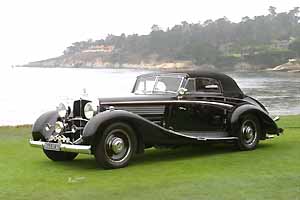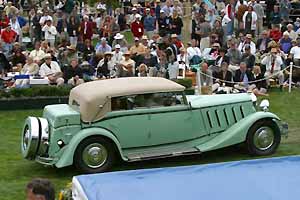www.maybach.de
The Maybach
Zeppelin models

Maybach-Zeppelin- Modelle |
Luxury and elegance
 The Maybach
"Zeppelin" is one of the most famous models in the line-up of international
luxury cars from the nineteen-thirties - a terrific twelve-cylinder car that
was built in numerous versions between 1930 and 1937. A contemporary test
report enthused "... The Maybach Zeppelin models rank among the few cars
in the international top class. They are highly luxurious, extremely lavish
in their engineering and attainable only for a chosen few, not only on account
of the small series in which these splendid cars are built." (Allgemeine
Automobilzeitung 1933, no. 35). The Maybach Zeppelin DS 8, model year 1932,
with chassis number 1387, and today owned by the Mercedes-Benz Museum, is
one of these luxury limousines. Its completely restored bodywork, specially
tailored by Messrs. Spohn in Ravensburg, is a four-door six-to-seven-seater
cabriolet with long wheelbase and ample space for feeling at ease in comfortable
leather chairs. Itself a feast for the eyes, the eight-litre V12 engine (number
25041) is still in a virtually "straight-from-the-factory" condition and
in perfect working order. It develops its power of 200 hp at a maximum of
3200 revolutions per minute in superior style - the epitome of smoothness
- and gives the car a top speed of 170 kilometres per hour. The Maybach
"Zeppelin" is one of the most famous models in the line-up of international
luxury cars from the nineteen-thirties - a terrific twelve-cylinder car that
was built in numerous versions between 1930 and 1937. A contemporary test
report enthused "... The Maybach Zeppelin models rank among the few cars
in the international top class. They are highly luxurious, extremely lavish
in their engineering and attainable only for a chosen few, not only on account
of the small series in which these splendid cars are built." (Allgemeine
Automobilzeitung 1933, no. 35). The Maybach Zeppelin DS 8, model year 1932,
with chassis number 1387, and today owned by the Mercedes-Benz Museum, is
one of these luxury limousines. Its completely restored bodywork, specially
tailored by Messrs. Spohn in Ravensburg, is a four-door six-to-seven-seater
cabriolet with long wheelbase and ample space for feeling at ease in comfortable
leather chairs. Itself a feast for the eyes, the eight-litre V12 engine (number
25041) is still in a virtually "straight-from-the-factory" condition and
in perfect working order. It develops its power of 200 hp at a maximum of
3200 revolutions per minute in superior style - the epitome of smoothness
- and gives the car a top speed of 170 kilometres per hour. |
Enthusiasm-inspiring handling
characteristics
 Its handling
characteristics fill people with enthusiasm even today. With its 3735 millimetre
wheelbase, high weight and rigid axles suspended on long semi-elliptic springs,
the car glides along in almost light-footed style. Comfort is additionally
enhanced by hydraulic, double-acting shock absorbers. The clutch has to be
operated for starting off, but otherwise, the driver only needs to operate
two small levers in the centre of the steering wheel to engage the four gears
of the planetary-gear transmission - without declutching. What a treat! Idle,
first and reverse gear are engaged by means of a preselection lever in the
centre of the car. In relation to this majestic car's weight of well over
three tonnes, the worm-and-nut steering, with-out power assistance, is
astonishingly light, and the huge drum brakes, actuated via cables, decelerate
the car evenly and effectively, thanks to an ingenious lever system. Thanks
to vacuum-pressure brake boosting, relatively little strength is required
to operate the brakes. Its handling
characteristics fill people with enthusiasm even today. With its 3735 millimetre
wheelbase, high weight and rigid axles suspended on long semi-elliptic springs,
the car glides along in almost light-footed style. Comfort is additionally
enhanced by hydraulic, double-acting shock absorbers. The clutch has to be
operated for starting off, but otherwise, the driver only needs to operate
two small levers in the centre of the steering wheel to engage the four gears
of the planetary-gear transmission - without declutching. What a treat! Idle,
first and reverse gear are engaged by means of a preselection lever in the
centre of the car. In relation to this majestic car's weight of well over
three tonnes, the worm-and-nut steering, with-out power assistance, is
astonishingly light, and the huge drum brakes, actuated via cables, decelerate
the car evenly and effectively, thanks to an ingenious lever system. Thanks
to vacuum-pressure brake boosting, relatively little strength is required
to operate the brakes.
| DaimlerChrysler Communications,
2003 |
Top |
